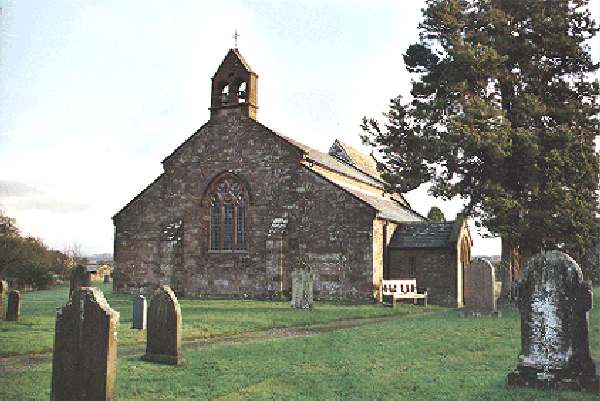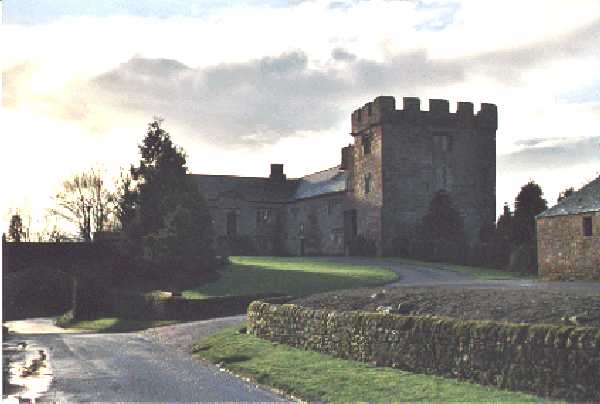Newton-Reigny is a neat village, on an eminence, 3 miles
N.W. by W. of Penrith. It derives its distinctive appellation from the family of De
Reigny, who had the manor in the reign of Henry II, and long held it by the service of
finding a horseman to serve against Scotland, armed with a coat of mail, an iron helmet, a
lance, and a long sword. The  manor of Newton is now part of
the possessions of the earl of Lonsdale, whose ancestor Hugh de Lowther obtained it in
1290, by will, from Robt. Burnell, bishop of Bath. The church 2
is a neat edifice, with a nave, side aisles, and chancel. The aisles are divided from the
nave by three pointed arches, with plain mouldings springing from octagonal piers. It has
long been appropriated to the See of Carlisle, but in 1635, owing to the insufficiency of
the curate's salary "it was ordered that the curate should have the whole rectory,
tithe corn excepted, out of which he should have £6 13s. 4d. yearly." This stipend
was afterwards advanced to £10 13s. 4d. In 1765, the perpetual curacy was
augmented with £400 which was laid out in land at Kirkstone Foot, and was given in two
equal donations by Dr. Holme and the governors of queen Anne's bounty. The bishop of
Carlisle is patron, the earl of Lonsdale lay impropriator, and the Revd. John B.
Wightwick, clerk, is the perpetual curate. The living is now worth about £80 a
year, exclusive of a house and garden; and the tithes of the parish were commuted in
manor of Newton is now part of
the possessions of the earl of Lonsdale, whose ancestor Hugh de Lowther obtained it in
1290, by will, from Robt. Burnell, bishop of Bath. The church 2
is a neat edifice, with a nave, side aisles, and chancel. The aisles are divided from the
nave by three pointed arches, with plain mouldings springing from octagonal piers. It has
long been appropriated to the See of Carlisle, but in 1635, owing to the insufficiency of
the curate's salary "it was ordered that the curate should have the whole rectory,
tithe corn excepted, out of which he should have £6 13s. 4d. yearly." This stipend
was afterwards advanced to £10 13s. 4d. In 1765, the perpetual curacy was
augmented with £400 which was laid out in land at Kirkstone Foot, and was given in two
equal donations by Dr. Holme and the governors of queen Anne's bounty. The bishop of
Carlisle is patron, the earl of Lonsdale lay impropriator, and the Revd. John B.
Wightwick, clerk, is the perpetual curate. The living is now worth about £80 a
year, exclusive of a house and garden; and the tithes of the parish were commuted in
 1839,
for £168 7s. 9d. viz. rectorial, £144 7s. 3d. and vicarial, £23 8s. 6d. There was
formerly a chantry in the church, but there is no evidence to show the nature of
its endowment, or by whom it was founded. Population 163.
1839,
for £168 7s. 9d. viz. rectorial, £144 7s. 3d. and vicarial, £23 8s. 6d. There was
formerly a chantry in the church, but there is no evidence to show the nature of
its endowment, or by whom it was founded. Population 163.
Catterlen is a hamlet, township, and manor, 3 miles N.W. by N. of Penrith. The manor of Catterlen was long held by the family of the Vaux, whose heiress bequeathed it to John Christian Curwen, Esq. of Workington Hall, from whom it passed by sale to the duke of Norfolk, and now belongs to Henry Howard, Esq. of Greystoke Castle. Catterlen Hall is a very ancient building erected by Rowland Vaux, in 1577, but as well as the old manor house at Newton, is now converted into a farm house. This township contains 1414 acres, of the rateable value of £889; and the township of Newton contains 978 acres, of the rateable value of £1026. Population, in 1841, 147 souls.
Mannix & Whellan, History, Gazetteer and Directory of Cumberland, 1847